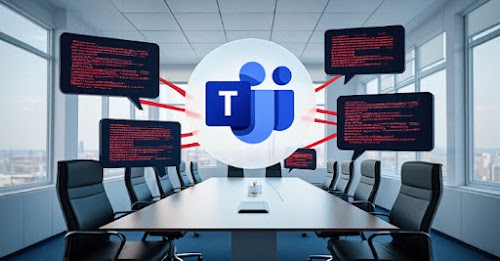
Hackers Leverage Microsoft Teams to Spread Matanbuchus 3.0 Malware to Targeted Firms
Unmasking Matanbuchus 3.0: When Microsoft Teams Becomes a Conduit for Covert Attacks
In the evolving threat landscape, even trusted communication platforms can become vectors for sophisticated malware campaigns. Recent advisories highlight a disturbing trend: hackers are actively leveraging Microsoft Teams to propagate a new, highly evasive variant of the Matanbuchus malware loader, dubbed Matanbuchus 3.0. This development demands immediate attention from IT professionals, security analysts, and developers responsible for organizational cybersecurity posture.
Understanding Matanbuchus: A Malware-as-a-Service Powerhouse
Matanbuchus is not a new name in the cyber underworld. It originated as a prominent Malware-as-a-Service (MaaS) offering, first appearing on underground forums in February 2021. Its primary function is to act as an initial access broker and a highly effective loader for subsequent, more damaging payloads. This modularity makes Matanbuchus an attractive tool for various threat actors, ranging from financially motivated cybercriminals to state-sponsored groups.
The inherent danger of Matanbuchus lies in its ability to facilitate the deployment of high-impact tools such as:
- Cobalt Strike Beacons: These post-exploitation tools allow attackers to maintain persistent access, move laterally within a network, and escalate privileges, often serving as a precursor to data exfiltration or ransomware deployment.
- Ransomware: Once Matanbuchus establishes a foothold, ransomware gangs can quickly encrypt critical systems and demand cryptocurrency payments, bringing business operations to a standstill.
The latest iteration, Matanbuchus 3.0, signifies a significant enhancement in its capabilities, primarily focusing on advanced stealth and evasion techniques designed to bypass conventional security measures.
The Microsoft Teams Vector: Exploiting Trust for Malicious Ends
The choice of Microsoft Teams as a distribution channel for Matanbuchus 3.0 represents a significant tactical shift by attackers. As a widely adopted collaboration platform, Teams is often seen as an internal, trusted communication channel. This trust is precisely what threat actors are exploiting.
Attackers likely leverage social engineering tactics to trick users into clicking malicious links or opening infected files shared within Teams. This could involve:
- Impersonating legitimate internal communications or external partners.
- Distributing seemingly harmless documents or files that, once opened, trigger the Matanbuchus infection chain.
- Utilizing compromised accounts to send malicious content from within the organization, lending an air of legitimacy to the attack.
The ease of file sharing and direct messaging within Teams makes it an ideal environment for spreading malware, especially when combined with sophisticated social engineering.
Matanbuchus 3.0: Enhancements in Stealth and Evasion
Cybersecurity researchers have highlighted that Matanbuchus 3.0 incorporates significant features aimed at improving its stealth and evading detection. While specific technical details may vary, these enhancements generally involve:
- Improved Obfuscation and Encryption: More robust techniques to hide the malware’s true nature, making it harder for antivirus and EDR (Endpoint Detection and Response) solutions to identify signature-based threats.
- Anti-Analysis Techniques: Mechanisms to detect and thwart sandboxing environments, debuggers, and virtual machines, preventing security analysts from fully understanding its behavior.
- Polymorphic Capabilities: The ability to change its code structure with each infection, further complicating signature-based detection.
- Advanced Persistence Mechanisms: More sophisticated ways to remain resident on compromised systems, even after reboots or security software scans.
These features collectively make Matanbuchus 3.0 a formidable threat that can remain undetected within networks for extended periods, providing ample opportunity for attackers to conduct reconnaissance and prepare for their next-stage objectives.
Remediation Actions and Proactive Defenses
Mitigating the threat posed by Matanbuchus 3.0, particularly when distributed via Microsoft Teams, requires a multi-layered approach focusing on technical controls, user education, and agile response strategies. There is no specific CVE associated with this malware variant itself, as it leverages existing platforms and social engineering.
Administrators should implement the following actions:
- Enhance Email and Chat Security:
- Implement robust email and chat filtering solutions to detect and block malicious links and attachments before they reach users.
- Configure Microsoft Teams security policies to restrict external sharing or file uploads to trusted sources where possible.
- Enable Safe Links and Safe Attachments within Microsoft 365 services to provide real-time protection against malicious content.
- Elevate Endpoint Detection and Response (EDR):
- Ensure EDR solutions are up-to-date and configured for maximum detection capabilities. Focus on behavioral detection signatures rather than just traditional signature-based ones.
- Regularly review EDR alerts and incidents, prioritizing those originating from communication platforms.
- Strengthen Network Segmentation:
- Apply network segmentation to limit lateral movement within the network if a compromise occurs. Minimizing the blast radius can contain spread.
- Implement Least Privilege Principles:
- Ensure users and applications operate with the minimum necessary permissions to perform their tasks.
- Conduct Regular Security Awareness Training:
- Educate users about the dangers of phishing, social engineering, and the importance of verifying sender identities, especially for unexpected attachments or links in Microsoft Teams.
- Train users to recognize suspicious activity within internal communication platforms.
- Backup and Recovery Strategy:
- Maintain regular, tested backups of critical data, ideally offline or in immutable storage, to facilitate recovery in the event of a successful ransomware attack.
- Threat Intelligence Integration:
- Leverage up-to-date threat intelligence feeds to identify indicators of compromise (IoCs) associated with Matanbuchus 3.0 and similar threats.
| Tool Name | Purpose | Link |
|---|---|---|
| Microsoft 365 Defender | Unified security for endpoints, identities, email, and apps, including Teams security features. | https://www.microsoft.com/en-us/security/business/microsoft-365-defender |
| EDR Solutions (e.g., CrowdStrike Falcon, SentinelOne) | Endpoint Detection & Response for behavior-based threat detection and response. | https://www.crowdstrike.com/products/falcon-platform/endpoint-detection-response/ https://www.sentinelone.com/platform/edr/ |
| Security Awareness Training Platforms (e.g., KnowBe4) | Educates users on phishing and social engineering tactics. | https://www.knowbe4.com/ |
| Network Access Control (NAC) Solutions | Restricts network access based on device compliance and user identity. | https://www.cisco.com/c/en/us/products/security/identity-services-engine/index.html |
Conclusion: Strengthening Cyber Resilience in a Shifting Landscape
The emergence of Matanbuchus 3.0, particularly its distribution via trusted platforms like Microsoft Teams, reaffirms the continuous need for vigilance and adaptive cybersecurity strategies. Organizations must recognize the inherent risks in collaboration tools and implement comprehensive security measures, combining advanced technical controls with robust user education. Proactive defense, swift incident response capabilities, and a deep understanding of evolving threat actor tactics are paramount in safeguarding digital assets against increasingly sophisticated malware campaigns.





